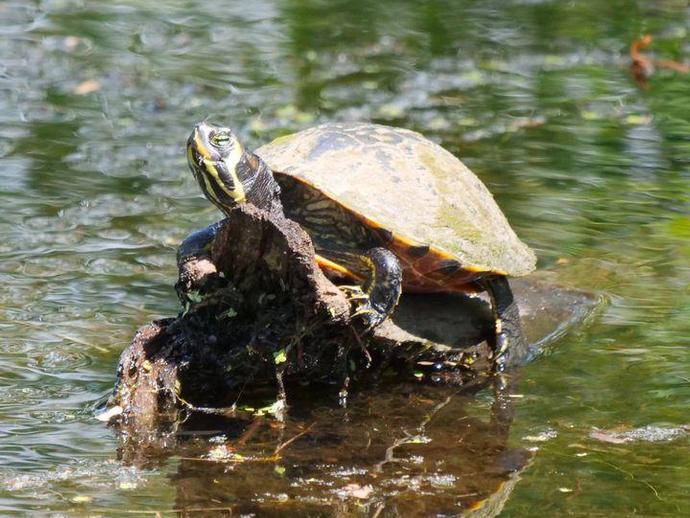May 20, 2021
Ben here with today's edition of #BenInNature presented by our friends at Carter Bank & Trust!
Here's a cool turtle that I spotted at Brick Pond Park in North Augusta, South Carolina: Trachemys scripta elegans, the red-eared slider!
The red-eared slider is perhaps the most famous turtle in the world. It's not just the most popular pet turtle in the U.S.; it's the most commonly traded reptile in the entire world! In fact, according to canon, the Teenage Mutant Ninja Turtles began their lives as red-eared sliders (prior to the mutations and ninja training).
Why the popularity? It's a combination of factors. They don't grow too large, they're easy to maintain, they don't cost much to purchase, and their food is fairly cheap as well. How could there possibly be a downside?
Unfortunately, there are several. For one, these turtles are asymptomatic carriers for Salmonella, a bacteria that causes diarrhea, fever, and stomach cramps in us humans. In fact, back in 1975, the FDA restricted the sale of red-eared sliders in the U.S. due to the many salmonella infections they caused (although many shady outfits still sell small red-eared sliders thanks to a few loopholes in the regulations).
However, the bigger problem with these turtles is that given their easy maintenance and adaptability, they're a perfect invasive species. In Australia and India, red-eared sliders have begun to establish populations and they readily outcompete the native turtle species.
These turtles were originally native to the central U.S., and while they can easily be found in Virginia (and South Carolina, like the one pictured here), these are unfortunately non-native populations. While it's tempting to turn wild animals into pets, we must always remember to exercise caution; even the best intentions can sometimes produce negative consequences.
Thank you to VMNH Research Associate and member of the Virginia Herpetological Society Jason Gibson for identifying this turtle!
ABOUT #BenInNature
Social distancing can be difficult, but it presents a great opportunity to become reacquainted with nature. In this series of posts, Administrator of Science Ben Williams ventures outdoors to record a snapshot of the unique sights that can be found in the natural world. New updates are posted Monday - Friday, with previous posts highlighted on the weekends. This series of posts is made possible thanks to the support of VMNH Corporate Partner Carter Bank & Trust (www.cbtcares.com).
NATURE PHOTO IDENTIFICATIONS
If you discover something in nature that you would like help identifying, be sure to message us right here on Facebook with a picture (please include location and date of picture) and we'll have our experts help you identify it!

 Hours & Admissions
Hours & Admissions Directions
Directions

